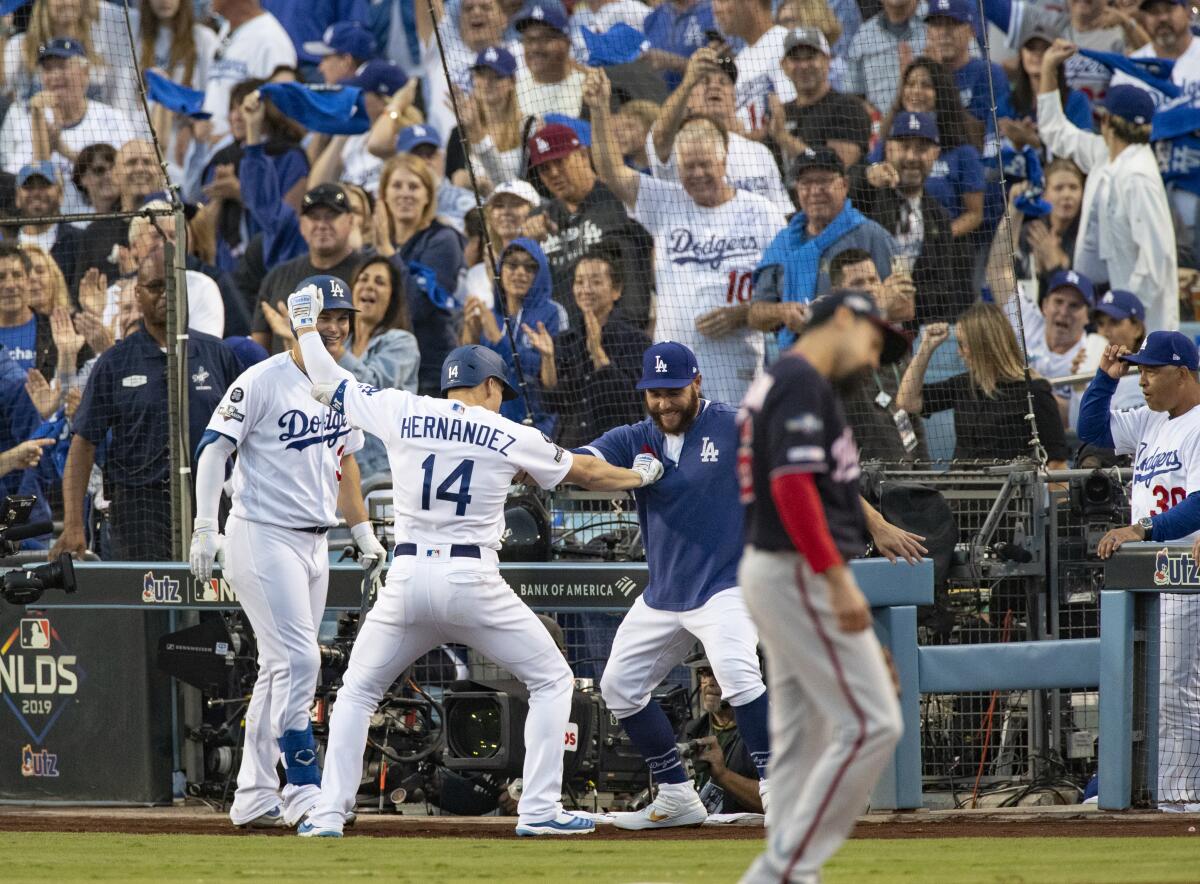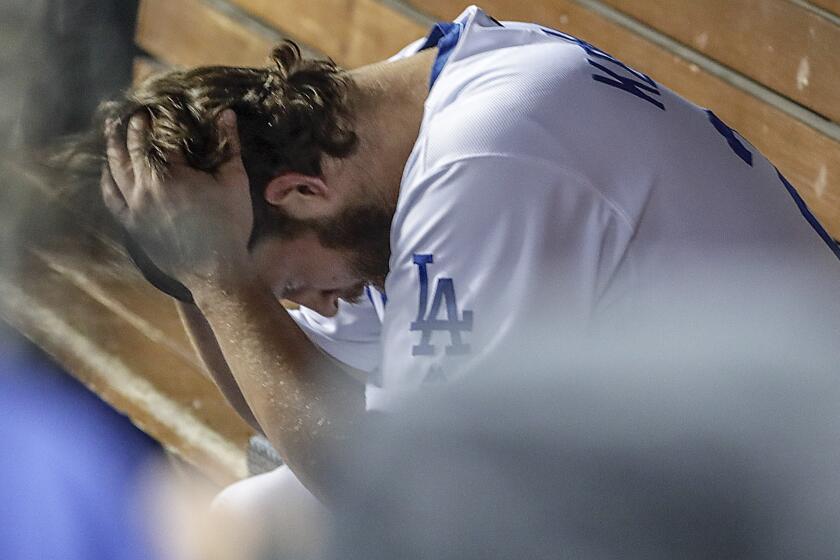Enrique Hernandez’s big impact in first NLDS start wasn’t enough for Dodgers

The Dodgers’ starting lineup for the National League Division Series Game 5 on Wednesday must have been a topic of debate, conflicting opinions and a sleepless night for team decision-makers. While the Washington Nationals’ lineup has been pretty much constant, the Dodgers had difficult decisions.
They went with Enrique Hernandez in left field instead of A.J. Pollock, and Matt Beaty on the right side of the infield instead of David Freese or Gavin Lux. Beaty played first base and Max Muncy moved from first to second base.
Hernandez paid immediate dividends. He blasted a solo home run just beyond the reach of left fielder Juan Soto in the second inning to extend the Dodgers’ lead to 3-0, moments after he made a sprawling catch of a shot by Soto.
Hernandez turned toward center field, but the drive by Soto, a left-handed hitter, began to tail toward the third-base line. Hernandez redirected his body and left his feet to make the catch near the warning track.
Soto gave him a salute and Dodgers right fielder Joc Pederson waved his cap to Hernandez in admiration.
Beaty was one for three before being removed as part of a double switch when Clayton Kershaw came in to pitch with two out in the seventh inning.
Hernandez also hit a single in the ninth but was stranded in what was ultimately a 7-3 loss in 10 innings to the Nationals.
Clayton Kershaw gives up back-to-back home runs before Joe Kelly surrenders a grand slam in the 10th inning of a 7-3 NLDS Game 5 loss to the Washington Nationals.
Fans appreciate protective netting
Cathy Paredes loves taking her seven-year old daughter, Cataleya, to Dodgers games. They don’t go to many games but when they do, they like to sit as close to the field as possible so Cataleya can see her favorite players.
As Paredes settled into her seat with her daughter a few rows up behind first base, she couldn’t help but notice the new extended netting at Dodger Stadium that wasn’t there when they attended a game earlier in the season.
“As a parent I feel more confident sitting here and enjoying myself and not worried about a ball coming this way,” she said. “We’ve sat before in this area and it is a concern. You can’t really relax as much. I notice the netting but you can still see the field well. It’s not impeding on my view of the game. I like it.”
The organization had already increased the height of the netting behind home plate and along the dugouts eight feet, reaching 33 feet. The 33-foot net now extends an additional 124 feet down the baseline and stop at the elbow bent in front of the baseline seats, several rows from the foul poles.
The installation came about a year after 79-year-old Linda Goldbloom died four days after she was hit in the head by a foul ball above the netting behind home plate. In June, the club said it was studying protective measures after a girl was hit in the head by a line drive beyond the netting down the first-base line. A boy also was hit by a line drive at Dodger Stadium during batting practice this season. Dodgers pitcher Rich Hill called for extended netting this summer.
“We would still sit here even if they didn’t put up the netting,” Parades said. “I appreciate that the Dodgers did this because it makes me more relaxed and I can just enjoy the game without worrying about a ball hitting us.”
A few rows in front of Parades, Marlene Raab was sitting with her husband, Edward, and their 8-year old daughter, Leah, and 13-year-old twin boys, Sebastian and Max. They didn’t really notice the netting as they got ready for the start of Wednesday’s game.
“I don’t mind the netting at all,” Marlene said. “Safety comes first. It doesn’t affect my view of the game. It’s fine. I would rather have this than not have it. It’s better than not having protection and getting hit by a foul ball. I would still bring the kids to the games even if they didn’t extend the netting but I just feel better that they did.”
Others without children weren’t as happy with the extended netting but realized it was part of the changing landscape of baseball.
“I prefer it without the net,” said Carlos Velasco, a 51-year old Dodgers fan from Los Angeles. “It’s a better view without the net. I was never concerned about the ball coming this way. I understand why they did it though.”
Umpire’s road to Chavez Ravine
Alfonso Marquez had never called a game pitched by Walker Buehler or Stephen Strasburg even though he’s been an MLB umpire since 1999. Few could have noticed.
His road to the major leagues is as unlikely as that of any player. Marquez was the first Mexican-born MLB umpire, and he came to the United States by squeezing through a border fence as a child.
Marquez, 47, is from a small town in Zacatecas, the son of a tombstone maker. His house had no running water. His father came to the U.S. first, found work as a dishwasher in Fullerton, then paid a coyote for bring his wife and two children.
They rode buses to Tijuana and at midnight crawled through a hole in a chain-link fence. He began umpiring as a teen in Fullerton, discovered he loved it and broke into the big leagues at age 27.
More to Read
Are you a true-blue fan?
Get our Dodgers Dugout newsletter for insights, news and much more.
You may occasionally receive promotional content from the Los Angeles Times.










